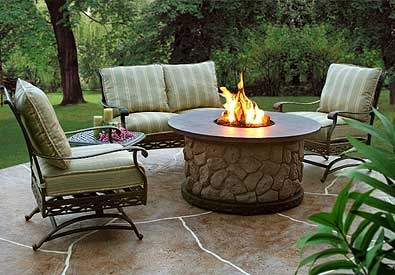The light breeze over the vacillating fence posts: good company, wine flowing freely, the sun setting just over the horizon.
For those with a backyard fire pit, this can be an everyday experience. There is comfort, relaxation, and simplicity in an outdoor fire – Not to mention a certain primal beauty. Below are a few tips for those looking to create a lasting outdoor space to complement their home design.
Types Of Fire Pits
There is an assortment of different shapes, styles, fuel, and materials to consider in store-bought fire pits: from wood burning, propane, or natural gas systems to chimineas, porcelain, cast iron, and steel. There are even brands of portable fire pits.
Depending upon the look that appeals to you, the price level, and the location, with so many choices, you can find a perfect complement to match your objectives for yard and garden improvements and the architectural elements of your home.
Determine the location of your fire pit and entertaining area. The pit itself is usually around four or five feet across which means the rest of the area should be an additional six feet on all sides. Place your fire pit where there is enough room to safely accommodate both the apparatus, seating, and design elements.
Understanding the prevailing winds in your yard is another factor to consider, as a continual breeze in one direction may impact the effectiveness of your fire pit, making half your company warmer than necessary while the rest huddle for warmth. A windbreak may be necessary for strong crosswinds. Placing your fire pit on one side or the other of your home may allow for a break in wind patterns.
Proper Safety Measures
The first step in the process of designing an outdoor fire pit is to mitigate any potential fire hazards in your garden and yard. For landscaping efforts and set-up around the fire pit trench, it’s good to plan ahead.
- Clear the grass which runs around your fire pit; dig a 2-inch deep perimeter around the device which extends approximately 4 feet from the edge of the fire area.
- Place landscaping fabric at the bottom of the dug hole. Landscaping fabric is used as a barrier against weeds and other such garden invaders; it allows the soil beneath it to breathe, letting in air, water, and nutrients from above. Simply secure the fabric with staples or stakes at approximately 4-foot intervals into the ground.
- From here, the home owner can choose to fill the 2-inch deep dig area with gravel, brick, concrete pavers, or flagstone. Arrange the fill over the landscape fabric in whatever design or style you think adds the best flavor and visual panache to the area.
- If choosing pavers or flagstone as fill items, pour in an inch of sand and then sweep the sand into the cracks in order to help with stabilization. Spray water in order to lock the sand in place and then apply pressure to pack it in completely.
- Now, for the chair placement: it’s important to create a barrier for your guests from the actual flame. Use common sense, but a placement of seating 2 to 2-½ feet from the outer edge of your fire appliance is smart and safe.
- To enhance the beauty of your fire pit, try adding color and texture with flowering plants at the perimeter of the area. Lavender or rosemary creates visual splendor and adds fragrance that elevates your fire pit to a sophisticated setting for gathering to eat, drink wine, and chat the night away.
Coordinating With Patio Decor
Adding a fire pit to an existing (or soon-to-be-built) patio can be a great way to incorporate beauty and comfort into your yard or nearby spaces. Visit your city or municipal building department to check building codes to find out if you need a permit. Determine if there are restrictions limiting the placement of a fire pit on your property.
Landscape designers often consider the design principles of feng shui when planning a backyard. The balance of objects in the space is highly important. For example, to create optimal feng shui, a water fountain or other water element should be placed across the yard from a fire pit. Water balances fire, and injects complementary elements into your backyard design.
To tie the design of your fire pit into the look of your patio, use the same brick as the home’s foundation. Try stucco in a color similar to the siding or trim. If your property has a rustic vibe, flagstone – discussed as one of the layering options above – can be used to create a country look to your back area.
Seating shouldn’t go completely around the fire pit protrusion. Instead, install a bench about halfway around and additional chair seating in the nearby vicinity. A “half-pit” design is an interesting option, which is created by placing a water fountain or wall behind the seating. This adds a distinct flavor to the area and creates a truly elegant space.
The key element in planning your backyard fire pit is to design a space that is as comfortable as possible. Consider the size of your fire element, traffic flow, and plans for repeated use. Incorporate the principles of feng shui and your personal taste in natural elements to create a visually appealing retreat.
A fire pit should fit your space and look as if it were meant to be there. A backyard fire is about comfort, friendship, relaxation, family, and good times. In the end, your new area is really what you make of it. Long after the design process has come and gone, you will be sitting out with friends and family, quite simply enjoying the night.
About the writer
Bryce Hammonsis an award-winning screenwriter and avid freelance writer covering a wide range of topics from education to technology and home improvements. Bryce writes for a variety of websites, including Catalogs.com.
